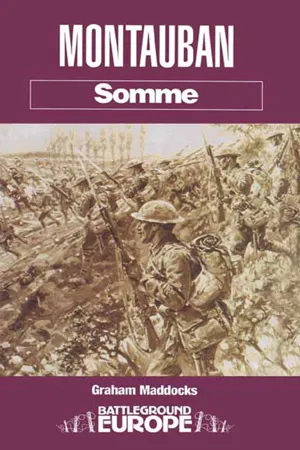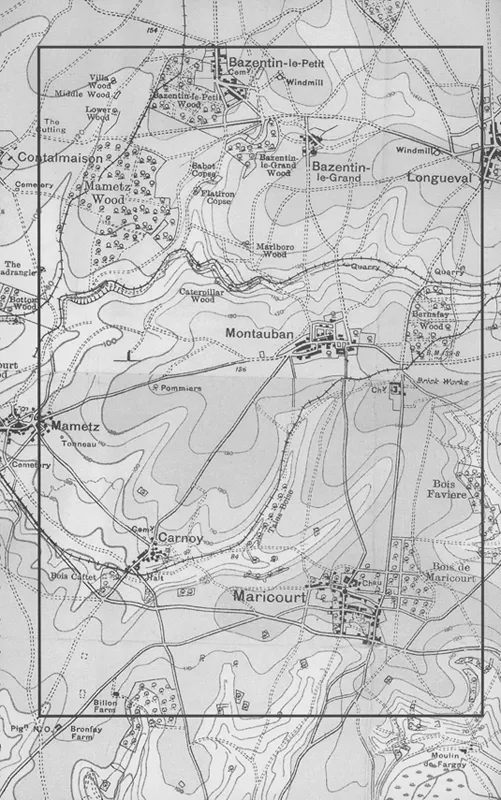
- 192 pages
- English
- ePUB (mobile friendly)
- Available on iOS & Android
eBook - ePub
About this book
Montauban was the southernmost of the Somme villages attacked by the British Army on 1 July, 1916, and it was where there was the greatest success. This new book in the series takes the reader over ground where Captain Nevill kicked a football on going over the top, where the Somme cameramen took some of their most evocative footage and where Pals battalions engaged in a triumphant first major engagement.
Frequently asked questions
Yes, you can cancel anytime from the Subscription tab in your account settings on the Perlego website. Your subscription will stay active until the end of your current billing period. Learn how to cancel your subscription.
At the moment all of our mobile-responsive ePub books are available to download via the app. Most of our PDFs are also available to download and we're working on making the final remaining ones downloadable now. Learn more here.
Perlego offers two plans: Essential and Complete
- Essential is ideal for learners and professionals who enjoy exploring a wide range of subjects. Access the Essential Library with 800,000+ trusted titles and best-sellers across business, personal growth, and the humanities. Includes unlimited reading time and Standard Read Aloud voice.
- Complete: Perfect for advanced learners and researchers needing full, unrestricted access. Unlock 1.4M+ books across hundreds of subjects, including academic and specialized titles. The Complete Plan also includes advanced features like Premium Read Aloud and Research Assistant.
We are an online textbook subscription service, where you can get access to an entire online library for less than the price of a single book per month. With over 1 million books across 1000+ topics, we’ve got you covered! Learn more here.
Look out for the read-aloud symbol on your next book to see if you can listen to it. The read-aloud tool reads text aloud for you, highlighting the text as it is being read. You can pause it, speed it up and slow it down. Learn more here.
Yes! You can use the Perlego app on both iOS or Android devices to read anytime, anywhere — even offline. Perfect for commutes or when you’re on the go.
Please note we cannot support devices running on iOS 13 and Android 7 or earlier. Learn more about using the app.
Please note we cannot support devices running on iOS 13 and Android 7 or earlier. Learn more about using the app.
Yes, you can access Montauban by Graham Maddocks in PDF and/or ePUB format, as well as other popular books in History & World War I. We have over one million books available in our catalogue for you to explore.
Information
CONTENTS
| Introduction by Series Editor | |
| Authors Introduction | |
| Acknowledgements | |
| How To Use This Book | |
| Chapter 1 | Preparations and Combatants |
| Chapter 2 | The Battle |
| Chapter 3 | Tours of The Old Battlefields |
| Chapter 4 | Men, Memorials and Memories |
| Bibliography | |
| Index |

The Madonna of Mountauban still intact in 1916 just after the capture of the village. British soldiers excavate an unexploded British howitzer shell at the base.
INTRODUCTION BY SERIES EDITOR
With this addition to the series, the old Front Line of 1 July 1916 has been completely covered south of the Albert-Bapaume Road. Graham Maddocks has been deeply involved in this sector; he is the author of the Liverpool Pals, who fought their first great battle here, and presided over the committee that raised the memorial to the Liverpool and Manchester Pals in the village.
Montauban was one of the rare places on the Somme where British endeavours were rewarded with success – in some cases, more than had been anticipated. One of the reasons for this lay in the German intelligence analysis, which reckoned that the British onslaught would fall from Gommecourt to just south of Fricourt, so that their resources, in particular engineering resources, were dedicated there. This goes some way to explaining the almost complete lack of success to the north; but it should not in any way detract from what was achieved by these soldiers from a nation which had so little continental military tradition behind it.
This book is considerably enhanced by the amount of work that Mr Maddocks has put into the early days of the war around Montauban, so that the fierce fighting which involved the French army as the line was being stabilised in autumn 1914 gets coverage. Too often we British tend to take the Somme battlefield as ours, and neglect the role of France. French soldiers bore the brunt of the war for its first two years, and the relevant chapter in this book is a timely reminder of that. One hopes that the notable efforts of the French Sixth Army, to the right of the British positions here at Montauban, will also be covered in depth at some stage. Graham Maddocks also gives an interesting account of the opponents of the British at Montauban, that extraordinarily effective fighting machine, the Imperial German Army. Whilst we neglect the French in our studies, we also neglect the Germans as well, and one has to face the fact that one of the reasons we had so many casualties was because of the tenacity and the ability to withstand punishment that was such a characteristic of the German soldier.
Visitors will find a wealth of detail and excellent walks in an area not overfull of remnants of this great conflict, which will help them to appreciate the achievement of the British soldier in this, the most successful part of the attack of 1 July, 1916.

Nigel Cave, Ely Place, London
INTRODUCTION
The story of the Battle of the Somme and more particularly its first day, are well known by the majority of the British public; in fact, it is ingrained into the folk memory of the British nation – yet the vast majority of its people have either gained the wrong impression of it, or are content to believe the oft-wheeled-out myths concerning it.
Popular belief holds that not only was it the most disastrous day in the history of the British Army – (in terms of disaster, the fall of Singapore in 1942 was actually much worse) – but that it was a total failure, wiping out the flower of British manhood for the gain of absolutely nothing.
It is fairly easy to see how this myth gained root – especially when one views the slaughter of some units on that sunny July morning in the third year of the war – slaughter without a shred of success. Curiously, often coupled with this myth is the equally false notion that all the men were brave heroes and all their officers, (especially the generals), incompetent buffoons!
Whilst it is not the purpose of this book to explore this hypothesis – it has been quite adequately deliberated over elsewhere – Montauban will nevertheless destroy a few well held beliefs as well as shattering a few myths. Even the mystique and magic of the date of the opening of the battle is confused in the minds of many. How often do we hear that 1 July was ‘the middle day of the middle year of the war’, for instance? In point of fact, 1916 was a leap year and thus had 366 days, so there was no middle day that year and in true calendar terms, the Great War might have spanned five years, but only lasted for just over four – so there was no middle year of the war either!
In many ways, the battle for Montauban is unique in the long struggle of the Battle of the Somme – the most obvious reason being that the village was the only one captured on schedule on 1 July, and the hopes and planning of 1 July were totally justified in military terms at Montauban. However, despite the delight it gave to British propaganda, the scale of the success there was soon lost to the grieving public as any euphoria which had accompanied the victory gave way to a chilling numbness. Once the terrible consequences of the attack further north became known, even the remarkable recovery and successes of the British Army on 2 July could not prevent the creeping realisation that it was not going to be an easy victory.
Nevertheless, what can never be disputed is the success of the 18th and 30th Divisions on that day – although even after the passage of more than eighty years, this is still not a well known or accepted fact. Despite obvious and catastrophic set-backs, the men of these two divisions accomplished near miracles over difficult and varying terrain and even though it is odious to compare their success with the total failure elsewhere, it is that very failure that has fuelled the public’s perception of the Somme battle ever since.
Who would readily believe, for instance, that a largely citizen army – composed mainly of men who had been civilians just two years earlier, albeit ‘stiffened’ by Regular Army battalions – could trounce the best of Germany’s might, who were professional, experienced and hitherto victorious?
Who would readily believe, also, that a battalion of 89 Brigade could capture all its objectives without actually losing a single soldier in action? It does seem impossible to a public conditioned to accept that all the attackers on the first day of the Somme gained no ground at all, yet were still wiped out, almost to a man – but it did happen.
It was the men of General Congreve’s XIII Corps attacking up the slopes of the Montauban Ridge that unseated a resolute German Army – a brilliant Army which had had twenty-one months to prepare for that inevitable day.
Their battle was virtually won on that July morning and certainly by the following day, they had ensured that the once red-roofed village of Montauban was safely back in allied hands and would never again have to suffer the agony and despoilation that became the routine fate of many other villages on the Somme.
When the author made his first pilgrimage to the Somme area in 1972 there were very few British visitors to the area, as most of the survivors were by then too old, and their sons and daughters had not yet retired and felt the need to research their family histories. Only devotees and serious students seemed to make visits. In fact, returning there for his next visit in 1973, (and every year since), the author was shocked to find that in some cemetery visitors’ books, his name from the previous year was the last one to be written!
For a variety of reasons, this is not now the case and there is a flourishing trade in commemorative visits as many thousands each year make regular pilgrimages. Whilst it is most important that the men buried there should never be forgotten, some could be forgiven for seeing these visits as a double-edged sword. For others, the Somme battle has engendered almost a cult of remembrance and the 1 July anniversary can not be allowed to pass without hordes of them, some curiously dressed in Great War period uniform, eating corned beef and sipping tots of rum, before prancing over the battlef...
Table of contents
- Cover
- Half Title Page
- Series Page
- Title Page
- Copyright Page
- Contents